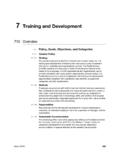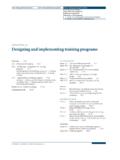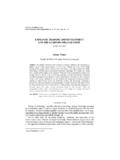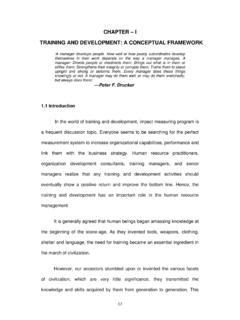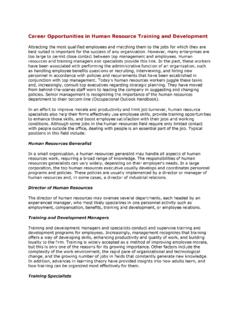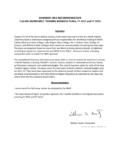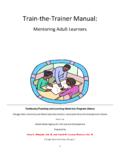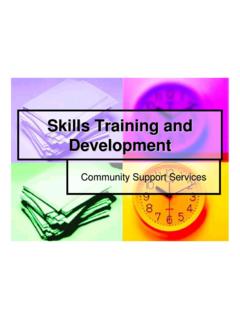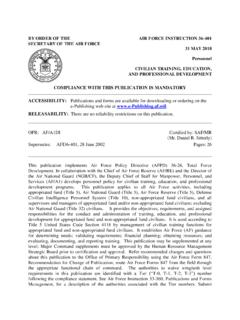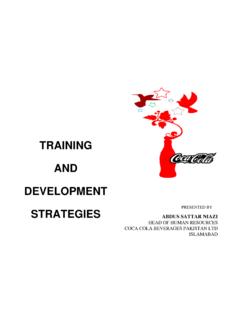Transcription of BY ORDER OF THE AIR FORCE INSTRUCTION 36 …
1 BY ORDER OF THE OF THE SECRETARY OF THE A IR FORCE AIR F ORCE INSTRUCTION 36-2201 15 SEPTEMBER 2010 Inc orporating Through Change 3, 7 August 2013 Personnel AIR F ORCE T RAINING PROGRAM COMPLIANCE WITH THIS PUBLICATION IS MANDATORY ACCESSIBILITY: Publications and for ms are ava ila bl e f or downloading or ordering on the e - Publishing website a t -publis RELEASABILITY: There are no releasibility restrictions on this publication. Supersede s: AFI 36-2201V1, 01 Octobe r 2002; AFI 36- 2201V2, 13 January 2004; AFI 36- 2201V3, 04 February 2005; AFI 36-2201V4, 23 Octobe r 2002; AFI 36- 2201V5, 08 June 2004; AFI 36-2201V6, 27 September 2002 Certif ied by: AF/A1DL (Col James E. Miner) Pages: 209 This instruc tion implements DoDD , Military training , 3 September 2004, DoDI , Deve lopment and Mana gement of Interactive Courseware (ICW) for Military training , 14 March 1991, with chang e 1, 16 November 1994, DoDI , development , Mana gement, and Delivery of Distributed Learning, 16 June 2006, and AFPD 36-22, 22 March 2004, Military training , for de ve loping, mana ging, and conducting Air FORCE (AF) technical, anc illary, and recruit training .
2 FORCE mana gement policies, responsibilities, and pr ocedures specific to AF-leve l quantitative recruit and technical training requirements are implemented in AFI 36-2616, Trained Personnel Requirements. This Air FORCE INSTRUCTION (AFI) applies to Total FORCE Active Duty, Air For ce Reserve , Air National Guard (ANG), and Department of Air FORCE Civilian. Ensure that all recor ds created as a result of pr ocesses prescribed in this publication are maintained in accordanc e with AFMAN 33-363, Management of Records, and disposed of in accordanc e with the Air FORCE Records Disposition Sche dule (RDS) located at Refer recommende d cha nges and questions about this publication to the O ffi ce of P rimary Responsibility (OPR) using the A F IMT 847, Recommendation for Cha ng e of Publication; route AF IMT 847s from the field through Major C ommands (MAJCOMS) publications/for ms mana gers.
3 2 AFI36-2201 15 SEPTEMBER 2010 SUMMARY OF C HANGES A margin bar (|) Indicates newly revised materials. Chapter 1 CONTINUUM OF LEARNING ( COL) 6 Description.. 6 FORCE development ( FD).. 6 Competencies.. 6 Expected Benefits: .. 6 Impact of C oL on Con tinu um of T raining .. 7 Chapter 2 training development AND DELIVERY 8 AF Instruc tional S ystems D esign (ISD): .. 8 Adv anced Distribu ted Learni ng (ADL): .. 13 ETCA.. 16 Chapter 3 BASIC MILITARY training (BMT) 18 Scope.. 18 Obj ectives of B MT and the PSSSE Orientation Course.. 18 BMT Oversight .. 18 Chapter 4 FORMAL training 21 Formal T raining Management.. 21 Special training .. 28 Table Organizations R esponsible for F unding , Managing , and Admini stering Special training .. 30 Managing , Admini stering , and Conducting AETC Type 6 Distance L earning (DL): .. 31 Field training .. 32 Initial S kill A FSC Awarding Traini ng Conducted by AETC (982 TRG) TDs.
4 33 Chapter 5 AIR FORCE CAREER FIELD MANAGEMENT 34 Scope.. 34 Air F orce Career F ield Manager ( AFCFM) R espons ibilities: .. 34 MAJCOM Functiona l Managers ( MFM).. 34 AETC training Pipeline Managers: .. 34 AETC training Managers ( AETC TM).. 35 Subject Matte r Expert ( SME).. 35 AFI36-2201 15 SEPTEMBER 2010 3 Career F ield Education and Traini ng Plan (CFETP): .. 35 CFETP Format: .. 35 Utilization & training Workshop (U&TW)/Specialty training Requirements Team (STRT) P roc edures: .. 40 Chapter 6 AIR FORCE ON-THE-JOB training ADMINISTRATION 48 Struc ture o f t he A ir FORCE On-The-Job training Prog ram: .. 48 Higher H eadquarters U SAF training Responsibilities.. 49 Base training Manager R esponsibilities.. 52 Base 3S2X1 FM Responsibili ties: .. 55 Commander R esponsibilities: .. 55 Uni t training Manager/Additiona l D ut y Unit training Manager R esponsibilities.
5 57 Supervisor, Trainer, Task Certifier, and Traine e R esponsibilities.. 61 training Forms and Documentation.. 65 CFETP (or E lectronic Equivalent).. 67 CDC P rog ram Management.. 72 Table CDC A dmini stration .. 73 Mandatory Craftsman Course Policies and Proc edures: .. 79 Table Assignment A vailability Codes.. 79 Chapter 7 ANCILLARY training 83 Prog ram Description.. 83 Requirements.. 83 Ancilla ry training Categor ies.. 83 Prog ram Responsibilities: .. 85 Air F orce Learning Committe e ( AFLC).. 87 Chapter 8 EXPEDITIONARY SKILLS training 91 Overview.. 91 Rol es and Respo ns ibilities.. 93 Establishing New/Revised EST R equirements.. 95 Pre-Deployment T raini ng Determina tion.. 96 Chapter 9 training EVALUATION 97 Scope.. 97 4 AFI36-2201 15 SEPTEMBER 2010 Evaluation Responsibilities: .. 97 Prescribed Forms: .. 97 Attachment 1 GLOSSARY OF REFERENCES AND S UPPORTING INFORMATION 99 Attachment 2 PREPARING AND PUBLISHING A C FETP 117 Attachment 3 OFFICER C FETP T EMPLATE 121 Attachment 4 ENLISTED C FETP T EMPLATE 130 Attachment 5 CHECKLIST FOR STRT/U&TW 147 Attachment 6 ASSOCIATED U &TW CORRESPONDENCE 153 Attachment 7 CONDUCTING training S TAFF ASSISTANCE V ISITS (SAV) 158 Attachment 8 STAFF ASSISTANCE VISIT C HECKLIST 164 Attachment 9 GUIDE FOR I NTERVIEWING PROSPECTIVE 3S2X1 RETRAINEES 171 Attachment 10 GUIDE FOR C ONDUCTING T HE UNIT training MANAGER S (UTM) T RAINEE ORIENTATION 174 Attachment 11 training S TATUS CODES AND D EFINITIONS TABLE 177 Attachment 12 GUIDE FOR C ONDUCTING T HE UTM T RAINING PROGRESS REVIEW 181 Attachment 13 MASTER training PLAN development G UIDE USING INSTRUCTIONAL SYSTEMS DESIGN (ISD) PRINCIPLES 182 Attachment 14 PROPOSAL FOR ANCILLARY training REQUIREMENT 187 Attachment 15 - DELETE.
6 188 Attachment 16 COURSE development DECISION L OGIC PROCESS 189 Attachment 17 DL POC RESPONSIBILITIES FOR MANAGING, ADMINISTERING, AND C ONDUCTING DL 191 Attachment 18 FORMAT F OR MEMORANDUM TO AETC/A3PZ UPON COMPLETION OF ANNUAL COURSE REVIEW 194 Attachment 19 training DETACHMENT ( TD) POLICY AND PROCEDURES 195 Attachment 20 - DELETE. 200 Attachment 21 training REQUIREMENTS APPROVAL R EQUEST 201 Attachment 22 training REQUIREMENTS APPROVAL PROCESS 203 Attachment 23 PRE-DEPLOYMENT T RAINING DETERMINATION PROCESS 204 AFI36-2201 15 SEPTEMBER 2010 5 Attachment 24 AIR FORCE CAREER development ACADEMY RESPONSIBILITIES 205 6 AFI36-2201 15 SEPTEMBER 2010 Chapter 1 CONTINUUM OF LEARNING (COL) Description. Deve loping Airmen is a top Air FORCE (AF) pr iority and de ve lopment al effor ts are key to the AF s ability to pr ovide warfighting assets to combatant commanders. These Airmen must possess the right combinations of both occupational and institutional competenc ies.
7 AF de velopmental effor ts span a career and are referred to as a CoL. It applies to all Airmen civilian and military, officer a nd enlisted, active duty, Guard, and reserve c omponents. FORCE development (FD). FORCE development is a function of education, training , and experience, which pr oduces ada ptive, creative, knowledge-enabled Airmen. Total FD is de signe d to be dyna mic and deliberate. It de pends on underlying processes that integrate and sync hr onize institutional requirements and senior leader perspectives. FD pr ocesses are facilitated by inputs from functional communities, commanders, and individual members, but must remain foc used on de livering institutional AF requirements. The CoL allows the AF to synchr onize FORCE de ve lopment using defined requirements. Competencies. One ke y portion of the requirements, the part that touche s all Airmen, is captured in the Institutional Competenc y List (ICL), found in AFPD 36-26, Total For ce Deve lopment.
8 The ICL serve s to pr ovide a common taxonomy underlying the CoL and to pr omote consistenc y AF-wide. All occupational models that include institutional competenc ies appearing on the ICL should use the labe ls and definitions contained in the ICL. Airmen increase their pr of icienc y in all competenc ies through AF FD pr ograms that include any combination of education, training and/or experience. These pr ograms should build on each other throughout the course of a career. AF de ve lopmental activities provide an opportunity to serve and excel, maintain pr omotion opportunity, and ba lanc e de pth and breadth of experiences to AF requirements. Expected B enefits: Aligns infrastructur e investments that are replicated across the AF ( systems, pr ocess definition, training , a nd maintena nce). Enables mana ge ment to be tte r assess, track, and defend deve lopment costs for the Total FORCE .
9 Enables the AF to transition to a smalle r FORCE , should that be required, that is able to expa nd its capa bilities to be tte r support the mission(s). Enables an AF-wide strategic FD framework to determine workf orce pr ojections, current and future c ompetenc y gaps, and emergent human capital needs. Provides a common lang uage and results in clearer understanding of AF FD pr ograms and initiatives, resulting in greater management efficienc ies. Provides a st andard foundation for determining requirements and standards for F D. More c learly ident ifies career pa ths for a ll Airmen with defined attainable st eps. Provides Airmen a clearer vision of goa ls and expe ctations and an understanding of what their perfor mance i s measured against. AFI36-2201 15 SEPTEMBER 2010 7 Impac t of CoL on Continuum of training . Based on the expected outcomes above, the CoL will standardize the requirements for FD.
10 This will ena ble the AF struc ture to reduce unnecessary duplication within the training pr oc ess, minimize anc illary training de mands, clarify the requirements process, and establish a c ommon training evaluation baseline . 8 AFI36-2201 15 SEPTEMBER 2010 Chapter 2 training development AND DELIVERY AF Instructional Systems Design ( ISD): The ISD pr ocess pr ovides a systematic approach to planning , de ve loping, and implementing training and education. The goa l of ISD is to increase the effectivene ss and cost efficiency of training by: de ve loping INSTRUCTION ba sed on job perfor manc e requirements; eliminating irreleva nt skills and knowledg e INSTRUCTION from courses; and ensuring graduates acquire the n ecessary knowledg e, skills, and abilities to do the job. The product of the ISD process is an instruc tional system that is cost effective and pr oduces personnel who can do the job.










